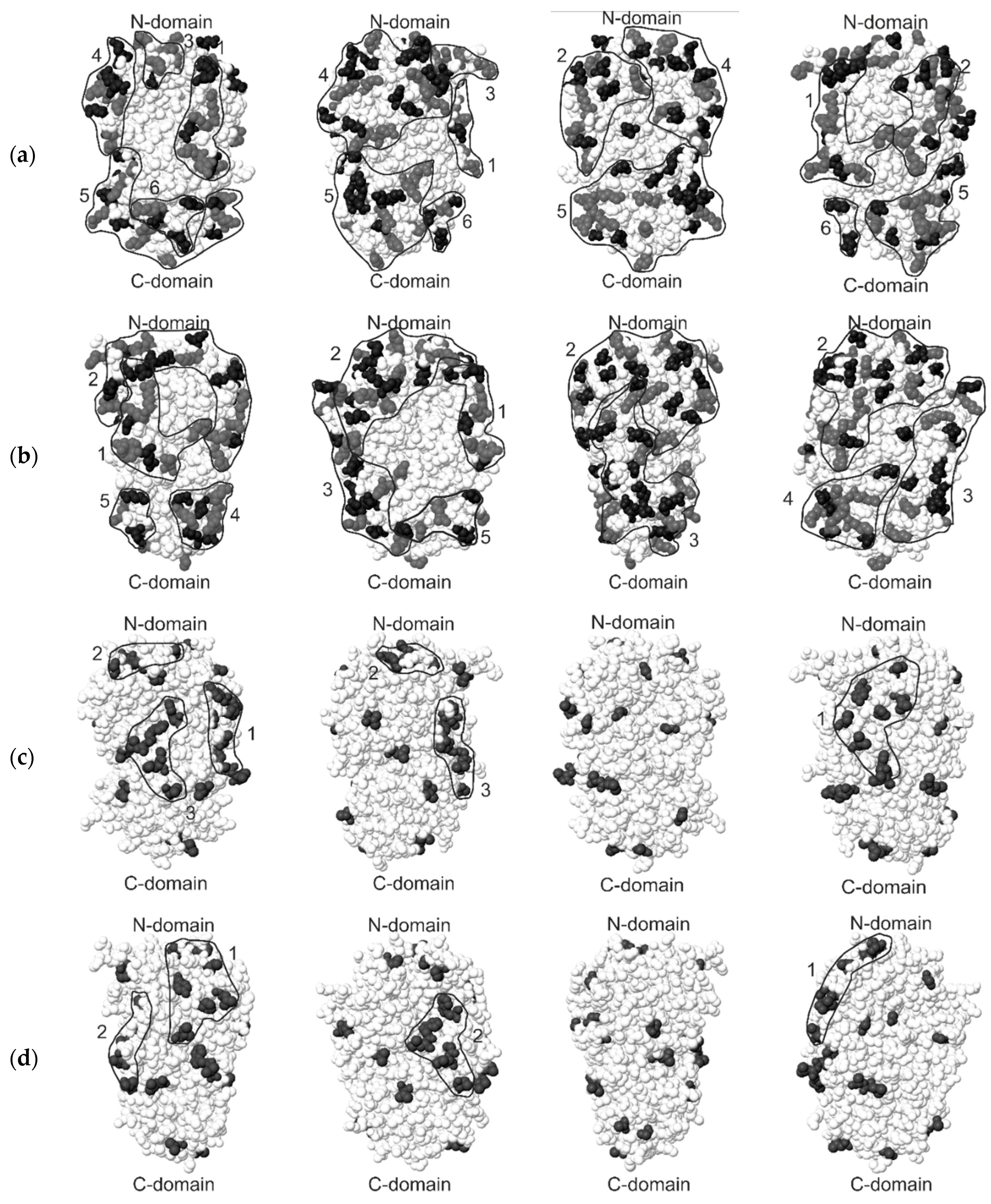Distribution of Charged and Hydrophobic Amino Acids on the Surfaces of Two Types of Beta-Fructosidase from Thermotoga Maritima †
Abstract
:1. Introduction
2. Methods
3. Results and Discussion
3.1. The Number and Composition of Amino Acids Clusters on Surfaces of the Enzymes
3.2. Distribution of Amino Acids on the Surfaces of the Enzymes
4. Conclusions
Author Contributions
Funding
Conflicts of Interest
References
- Davies, G.; Henrissat, B. Structures and mechanisms of glycosyl hydrolases. Structure 1995, 3, 853–859. [Google Scholar] [CrossRef]
- Pons, T.; Naumoff, D.G.; Martínez-Fleites, C.; Hernández, L. Three acidic residues are at the active site of a β-propeller architecture in glycoside hydrolase families 32, 43, 62, and 68. Proteins 2004, 54, 424–432. [Google Scholar] [CrossRef] [PubMed]
- Cao, L. Immobilized enzymes: Science or art? Curr. Opin. Chem. Boil. 2005, 9, 217–226. [Google Scholar] [CrossRef] [PubMed]
- Sheldon, R.A.; van Pelt, S. Enzyme immobilization in biocatalysis: Why, what and how. Chem. Soc. Rev. 2013, 42, 6223–6235. [Google Scholar] [CrossRef] [PubMed]
- Gray, C.J.; Weissenborn, M.J.; Eyers, C.E.; Flitsch, S.L. Enzymatic reactions on immobilized substrates. Chem. Soc. Rev. 2013, 42, 6378–6405. [Google Scholar] [CrossRef] [PubMed]
- Rodrigues, R.C.; Ortiz, C.; Berenguer-Murcia, Á.; Torres, R.; Fernández-Lafuente, R. Modifying enzyme activity and selectivity by immobilization. Chem. Soc. Rev. 2013, 42, 6290–6307. [Google Scholar] [CrossRef] [PubMed]
- Mateo, C.; Palomo, J.M.; Fernandez-Lorente, G.; Guisan, J.M.; Fernandez-Lafuente, R. Improvement of enzyme activity, stability and selectivity via immobilization techniques. Enzym. Microb. Technol. 2007, 40, 1451–1463. [Google Scholar] [CrossRef]

| Thermotoga maritima 1UYP | Thermotoga maritima 1W2T | |
|---|---|---|
| Clusters of Charged Residues | ||
| No. 1 | Lys3, Arg37, Lys38, Glu40, His59, Asp67, Asp68, Glu69, Lys269, Arg270, Glu271 | Lys3, Arg37, Lys38, Glu40, His59, Glu69, Asp94, Lys269, Arg270, Glu271 |
| No. 2 | Lys25, Lys27, Asp52, His56, Arg58, Glu80, Asp82, Lys84, Glu111, Asp115, Arg143 | Lys25, Lys27, Asp52, His56, Arg58, Asp67, Asp68, Glu80, Asp82, Lys84, Arg93, Lys99, Glu101, Lys102, Glu111, Asp115, Lys118, Asp120, Lys127, Glu130, Glu131, His134, Arg143, Glu147, Asp157, Glu158, Lys159, Asp169, His173, Lys175, Glu177, Glu182, Glu184, Lys187, Lys224, Arg230 |
| No. 3 | Arg93, His97, Lys99, Glu101, Lys102, Lys127 | Arg196, Glu199, Lys221, Glu222, Glu228, Lys229, Glu286, Glu289, Glu333, Arg351, Asp352, Glu353, Lys370, Glu374, Asp375, Glu376, Arg380, Asp396, Lys416, Lys421 |
| No. 4 | Glu130, Glu131, Glu147, Lys156, Asp157, Glu158, Lys159, Asp169, His173, Lys175, Glu177, Glu182, Glu184, Lys187, Arg196, Glu199, Lys221, Glu222, Lys224, Glu228, Lys229, Arg230 | Asp296, Arg302, Lys303, Arg304, Lys305, Glu308, Asp318, Lys320, Glu321, Glu426 |
| No. 5 | Glu286, Glu289, Asp296, Arg302, Lys303, Arg304, Lys305, Glu308, Lys311, Asp318, Lys320, Glu321, Glu333, Arg337, Arg351, Asp352, Glu353, Arg369, Lys370, Glu374, Asp375, Glu376, Arg380, Asp396, Lys416, Lys421 | Glu335, Arg337, Glu341, Arg360, Glu407 |
| No. 6 | Glu341, Glu344, Arg360, Glu407 | |
| Clusters of hydrophobic residues | ||
| No. 1 | Ile11, Pro36, Pro61, Tyr65, Leu114, Val117, Trp431 | Ile11, Pro61, Tyr65, Leu114, Val117, Tyr119, Gly121, Pro123 |
| No. 2 | Pro123, Pro128, Pro129, Gly132, Tyr176 | Trp41, Trp260, Leu261, Gly264, Leu265, Val363 |
| No. 3 | Trp41, Trp260, Leu261, Gly264, Leu265, Val363 | |
Publisher’s Note: MDPI stays neutral with regard to jurisdictional claims in published maps and institutional affiliations. |
© 2020 by the authors. Licensee MDPI, Basel, Switzerland. This article is an open access article distributed under the terms and conditions of the Creative Commons Attribution (CC BY) license (https://creativecommons.org/licenses/by/4.0/).
Share and Cite
Sakibaev, F.; Holyavka, M.; Koroleva, V.; Artyukhov, V. Distribution of Charged and Hydrophobic Amino Acids on the Surfaces of Two Types of Beta-Fructosidase from Thermotoga Maritima. Chem. Proc. 2020, 2, 4. https://doi.org/10.3390/ECCS2020-07550
Sakibaev F, Holyavka M, Koroleva V, Artyukhov V. Distribution of Charged and Hydrophobic Amino Acids on the Surfaces of Two Types of Beta-Fructosidase from Thermotoga Maritima. Chemistry Proceedings. 2020; 2(1):4. https://doi.org/10.3390/ECCS2020-07550
Chicago/Turabian StyleSakibaev, Farkhat, Marina Holyavka, Victoria Koroleva, and Valeriy Artyukhov. 2020. "Distribution of Charged and Hydrophobic Amino Acids on the Surfaces of Two Types of Beta-Fructosidase from Thermotoga Maritima" Chemistry Proceedings 2, no. 1: 4. https://doi.org/10.3390/ECCS2020-07550
APA StyleSakibaev, F., Holyavka, M., Koroleva, V., & Artyukhov, V. (2020). Distribution of Charged and Hydrophobic Amino Acids on the Surfaces of Two Types of Beta-Fructosidase from Thermotoga Maritima. Chemistry Proceedings, 2(1), 4. https://doi.org/10.3390/ECCS2020-07550





